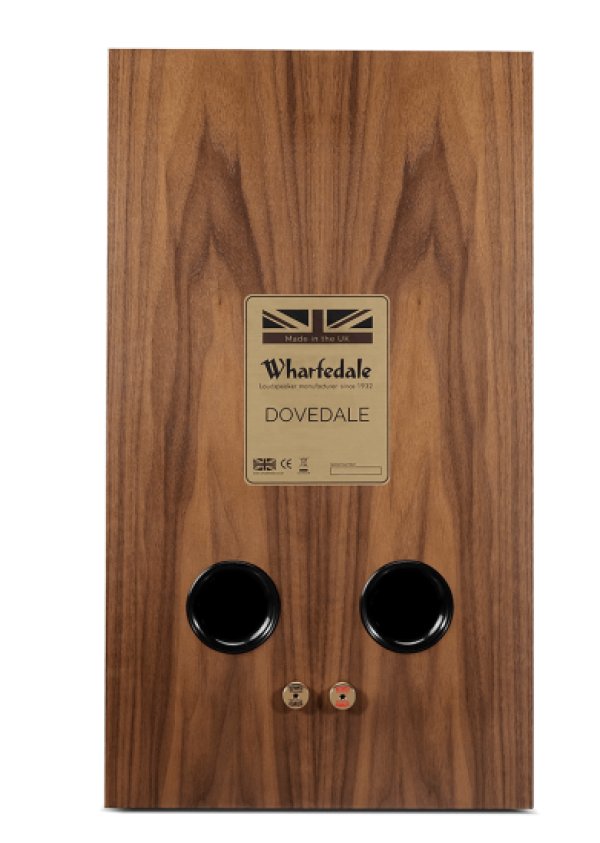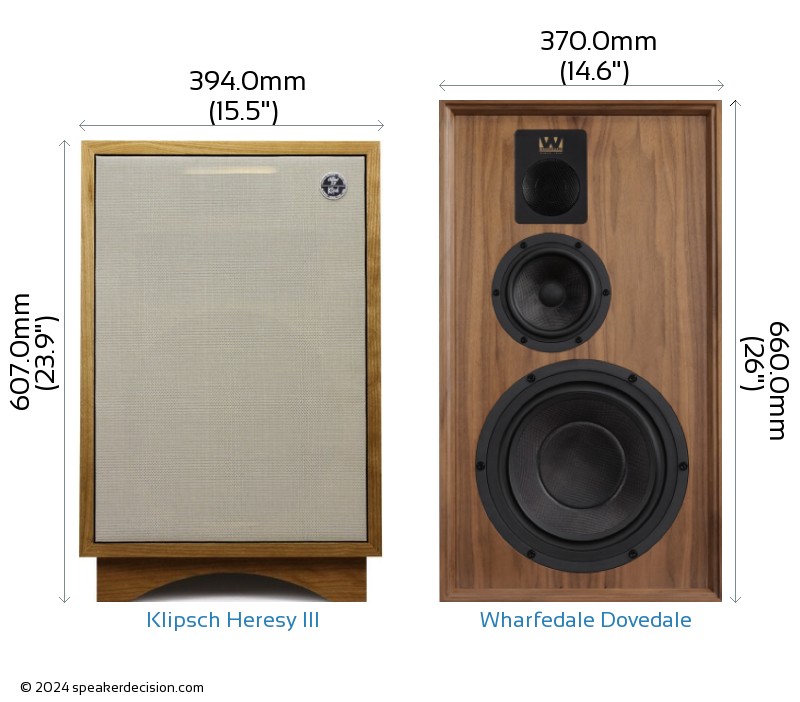In this review, we will be comparing two different type of speakers . Klipsch Capitol Heresy III is a Floor-standing speaker whereas the Dovedale is a Bookshelf speaker.
Let's have a brief look at the main features
of Klipsch Heresy III and Wharfedale Dovedale first before getting into our more
detailed comparison.
Klipsch Heresy III Key Specs
- 3-way Design
- 1" Tractrix horn Tweeter
- 1.75" Midrange
- 12" Fiber-composite Woofer
- 58-20k Hz Frequency Response
- 99 dB Sensitivity
- Impedance: 8ohms
- Power Range:100watts
- Weight:20.00kg
- Dimensions (H x W x D): 607.0" x 15-1/2" x 13-7/16"( 607.0 x 394.0 x 342.0mm )
Wharfedale Dovedale Key Specs
- 3-way Design
- 1" soft dome Tweeter
- 5" Midrange
- 10" black woven Kevlar cone Woofer
- 5" Midrange
- 36-20K HZ Frequency Response
- 89 DB Sensitivity
- Impedance: 6.5ohms
- Power Range:25-250watts
- Weight:26.20kg
- Dimensions (H x W x D): 660.0" x 14.6" x 16.4"( 660 x 370 x 417mm )
Heresy III and Dovedale are members of Wharfedale's Heritage series of speakers. Below you can find the loudspeakers from this series.
Klipsch Heritage Series
History
In the following sections, we will get into more detail in order to better understand how the Klipsch Heresy III and Wharfedale Dovedale compare and hopefully end up with enough arguments to decide which one of these loudspeakers is the better choice for you.
**This post contains affiliate links, and I will be compensated if you make a purchase after clicking
through my links. As an Amazon Associate I earn from qualifying purchases.
Drivers
Both Heresy III and Dovedale are 3-way speakers.
| Driver |
Klipsch Heresy III |
Wharfedale Dovedale |
|
Driver Setup
|
3-way
|
3-way
|
|
Tweeter
|
1-inch
|
1-inch
|
|
Midrange
|
1 x 1.75-inch |
1 x 5-inch |
|
Woofer
|
1 x 12-inch
|
1 x 10-inch
|
Heresy III features a 1" titanium-diaphragm compression Tractrix horn Tweeter , a 1.75" Midrange and 1 x 12" Fiber-composite Woofer . On the other hand, the Dovedale features a 1" soft dome Tweeter , a 5" Midrange and 1 x 10" black woven Kevlar cone Woofer with a Crossover frequency at 560Hz and 2900Hz.
Frequency Response
Heresy III has a frequency range of 58-20k Hz whereas Dovedale has a frequency range of 36-20K HZ. With a minimum frequency of 36Hz, the Dovedale can go significantly deeper on the low side and provide stronger bass compared to the Heresy III's min frequency of 58Hz.
Below graphs depict how these two speakers compare with the max, min and average values of the Min and Max Frequencies of other speakers in the Floor-standing class in our database.
Low Frequency
Floor-standing Speakers
High Frequency
Floor-standing Speakers
None of these speakers achieves full range experience which is commonly agreed as 20Hz-20kHz. In order to achieve lower lows / deeper bass, we recommend you pair these with a subwoofer. Visit our Powered Subwoofers section to find out more about the available options.
Impedance and Sensitivity
Heresy III is a 8 ohms speaker compared to the Dovedale which has a nominal impedance of 6.5 ohms.
These two speakers also have different sensitivity levels. Heresy III sensitivity is rated at 99 dB and the Dovedale's is rated at 89 DB. This 10 dB difference makes the Klipsch Heresy III a more sensitive speaker compared to Wharfedale Dovedale, hence will play louder with the same amount of watts.
Sensitivity
Floor-standing Speakers
Power Range
Power
range is the range of input power in watts RMS that a loudspeaker is designed to handle. While using
an amplifier within this range ensures the nominal performance , inputting a power that is higher than the
max wattage can result in a damaged speaker.
Heresy III can handle a max power of 250 watts RMS from the amp the whereas Heresy III has a max power handling value of 100 watts RMS , 150 watts less than the Dovedale.
Keep in mind that a higher max power handling value doesn't necessarily make that a louder speaker
compared to a lower max handling speaker. Loudness or the sound level is also impacted by parameters
such as Impedance, sensitivity and system efficiencies.
Input Type and Bi-Amping / Bi-Wiring
Heresy III features 5-way post posts which make bi-amping or bi-wiring possible. Dovedale has a Post which doesn't feature bi-amping/bi-wiring.
 Wharfedale Dovedale's Post terminals
Wharfedale Dovedale's Post terminals
Physical Specs
Size of a speaker can sometimes become an important decision factor due to space constraints or in some cases purely for esthetic reasons. In this section, we are going to compare Klipsch Heresy III's and Wharfedale Dovedale's external dimensions. Klipsch Heresy III has external dimensions of 607.0 x 394.0 x 342.0mm ( 23-7/8 x 15-1/2 x 13-7/16inch) whereas Wharfedale Dovedale has external dimensions of 660 x 370 x 417mm ( 23.6 x 14.6 x 16.4 inch) .
Klipsch Heresy III is 53mm shorter and 75mm less deeper than Wharfedale Dovedale but it is also 24mm wider.
Below you can see the front view size comparison of Klipsch Heresy III and Wharfedale Dovedale in scale.
 Comparison image of Klipsch Heresy III and Wharfedale Dovedale Size and External Dimensions
Comparison image of Klipsch Heresy III and Wharfedale Dovedale Size and External Dimensions
Base Surface Area Comparison
Base surface area of a loudspeaker may become a determining factor when the space in your room or desk is limited.
The base surface area of the Klipsch Heresy III is approximately 1347.5cm2 / 208.9inch2 and base area of the Wharfedale Dovedale is approximately 1542.9cm2 / 239.1inch2. The Heresy III requires 13% less surface area than the Dovedale which gives it a small advantage on placement in tight spaces.
What's in the Box of Klipsch Heresy III?
Here are the items that are included inside the box of Heresy III:
Floor-standing loudspeakerDetachable grille (installed)Base riser (installed)4 Self-adhesive rubber feetOwners ManualCongratulations letterKlipsch brochure